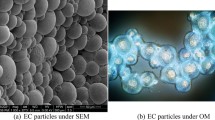Abstract
The resistance of mortars made of dolomite and quartz aggregate with and without polypropylene fibers has been studied at a nominal heating rate of 30∘C/min from room temperature up to 1000∘C. It is demonstrated that the key parameters that affect the performance of plain mortars are volume instability, phase transformation, aggregate dissociation, and permeability. Experimental results point at the major role of aggregate type on mass loss, porosity, volume instability, microstructure, cracking pattern, and mechanical properties. Three thermal zones are identified; low (up to about 300∘C), intermediate (about 300 to 600∘C), and high (>600∘C). It is shown that in the low thermal zone, the mechanical properties are about the same or better than those at room temperature. The intermediate thermal zone is characterized by a moderate decline of mechanical properties, whereas a rapid decline is registered in the high thermal zone.
Explosive spalling due to pressure built-up of volatiles took place at temperatures over 200∘C. Addition of polypropylene fibers prevents spalling due to the occurrence of porous and permeable interface between the fibers and the matrix rather than fiber shrinkage or melting.
Similar content being viewed by others
References
Neville AM (1981) Properties of Concrete. Pitman Publishing, 3rd Ed, London p. 779.
Sullivan PJE (2004) A probabilistic method of testing for the assessment of deterioration and explosive spalling of high strength concrete beams in flexure at high temperature. Cem Concr Composites 26:155–162.
Khoury GA, Grainger BN, Sullivan PJE (1985) Transient thermal strain of concrete: literature review, conditions within specimen and behavior of individual constituents. Materials and Structures 37(132):131–144.
Malhotra HL (1956) The effect of temperature on the compressive strength of concrete. Materials and Structures 8(22):85–94.
Phan LT (1996) ‘Fire Performance of High-Strength Concrete: A Report of the State-of-the-Art. NISTIR 5934, Building and Fire Research Laboratory, NIST, Gaithersburg, p. 105.
Hammer TA (1992) High strength concrete, Phase 3. SP6 Fire resistance-report 6.2, Spalling Reduction through Material Design, SINTEF, STF70 F92156, Trondheim, Norway.
Sanjayan S, Stocks J (1993) Spalling of high-strength silica fume concrete in fire. ACI Mat J 90(2):170–174.
Phan LT, Lawson JR, Davis FL (2001) Effects of elevated temperature exposure on heating characteristics, spalling and residual properties of high performance concrete. Mat Structures 34:83–91.
Bažant ZP, Thonguthai W (1979) Pore pressure in heated concrete walls: theoretical prediction. Materials and Structures 31(107):67–76.
Bilodeau A, Kodur VKR, Hoff GC (2004) Optimization of the type and amount of polypropylene fibers for preventing the spalling of lightweight concrete subjected to hydrocarbon fire. Cem Concr Composite 26:163–174.
Sullivan and Associates (2001) Deterioration and spalling of high strength concrete under fire. Offshore Technology Report 2001/074.
Bostrom L (2003) Self-compacting concrete exposed to fire. In proc. of 3rd International Symposium on Self-Compacting Concrete, Reykjavik, Iceland.
Eurocode 2 (1985) Design of concrete structures, Part 1–2: General Rules-Structural fire design.
RILEM TC 44-PHT: ‘Properties of materials at high temperatures’.
RILEM TC 74-THT, Test methods for high temperature properties.
RILEM TC 129-MHT, Test methods for mechanical properties of concrete at high temperatures.
Dehn F, Konig G (2003) Fire resistance of different fiber reinforced high-performance concretes. In proc. of High Performance Fiber Reinforced Cement Composites, HPFRCC, Ann Arbor, USA.
ASTM C (1988) Making and curing concrete test specimens in the laboratory.
ASTM C, (1994) Electrical Indication of Concrete's Ability to Resist Chloride Ion Penetration.
Sobczyk K, Kirkner DJ (2001) Stochastic modeling of microstructures. Birkhauser, Boston Basel Berlin.
Fenner CN (1913) The stability relations of the silica minerals. Amer Jour Sci 4th 36:331.
Berry LG, Mason B (1959) Mineralogy Concepts Descriptions Determinations. W.H. Freeman Company, San Francisco, p. 630.
Deer WA, Howie RA, Sussman J (1980) An Introduction to the Rock-Forming Minerals. Longman, London, p. 528.
Schneider U, Diederichs U (1981) Physical properties of concrete from 20°C up to melting. Parts 1 and 2. Betonwerk and Fertigteiltechnik, Heft 3 and 4.
Bažant ZP, Kaplan MF (1996) Concrete at high temperatures, Material properties and mathematical models. Longman, England.
Janotka I, Nürnbergerová T, Nadˇ L (2000) Behavior of high-strength concrete with dolomitic aggregate at high temperatures. Mag of Concrete Res 52(6):399–406.
Engler P, Santana MW, Mittleman ML, Balasz D (1988) Non-isothermal in situ XRD analysis of dolomite decomposition. The Rigaku Journal 5(1):3–8.
Samtami M, Skrzypczak-Janktun E, Dollimore D, Alexander K (2001) Thermal analysis of ground dolomite, confirmation of results using an X-ray powder diffraction methodology. Thermochimica Acta 367–368:297–309.
Castillo C, Durrani AJ (1990) Effect of transient high temperature on High-Strength Concrete. ACI Material Journal 87(1):47–53.
Yu-fang FU (2003) Thermal stresses and associated damage in concrete at elevated temperatures. A thesis for the Degree of Doctor of Philosophy, The Hong Kong Polytechnic University.
Phan LT, Lawson JR, Davis FL (2001) Effects of elevated temperature exposure on heating characteristics, spalling, and residual properties of high performance concrete. Materials and Structures 34:83–91.
Lea FM (1971) The Chemistry of Cement and Concrete. 3rd ed. Chemical Publishing Company, New York, p. 727.
Peng GF, Chan SYN, Anson M (2001) Chemical kinetics of C-S-H decomposition in hardened cement paste subjected to elevated temperatures up to 800°C. Adv. Cem. Res. 13(2):47–52.
Handoo SK, Agarwal S, Agarwal SK (2002) Physicochemical, mineralogical, and morphological characteristics of concrete exposed to elevated temperatures. Cem. Concr. Res. 32(7):1009–1018.
Khoury GA (1992) Compressive strength of concrete at high temperatures: A reassessment. Mag. Concr. Res. 44(161):291–309.
Kalifa P, Chene G, Galle Ch, (2001) High-temperature behavior of HPC with polypropylene fibers: From spalling to microstructure. Cement and Concrete Research 31:1487–1499.
Hertz KD (2003) Limits of spalling of fire-exposed concrete. Fire Safety Journal 38:103–116.
Author information
Authors and Affiliations
Additional information
An erratum to this article can be found at http://dx.doi.org/10.1617/s11527-006-9198-5
Rights and permissions
About this article
Cite this article
Matesová, D., Bonen, D. & Shah, S.P. Factors affecting the resistance of cementitious materials at high temperatures and medium[0] heating rates. Mater Struct 39, 455–469 (2006). https://doi.org/10.1007/s11527-005-9041-4
Received:
Accepted:
Published:
Issue Date:
DOI: https://doi.org/10.1007/s11527-005-9041-4




